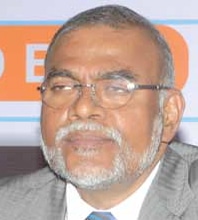
Dr Narendra Jadhav,
Member, Planning Commission, Government of India
Skills and knowledge are the driving forces of economic growth and social development
A plethora of untapped opportunities stare back at our faces from every direction. It is pretty clear to most of us that India and many other developing countries are grossly under-invested in education. This will matter enormously as human numbers and appetites crest in the next few decades.
Due to rapid transformation in school education, changing the patterns of teaching and learning have become a primary need. In today’s highly competitive world, children have to be endowed with the ability of developing original ideas. The educational process must facilitate and encourage such students. The future belongs to those who have original ideas.
Ideas and innovations, it is said emerge not out of luck but out of mankind’s need. Be it the wheel, Facebook, Hotmail or the cell phone, each and every innovation that we take for granted in our life has begun its journey with the identification of a particular need in the society.
Teachers and school leaders, who bravely grasp emerging opportunities, will be able to re-imagine their teaching methodologies and will be in a better position to serve their pupils. However, we have not prepared ourselves for the rate of change or the consequences of change.
India’s demographic dividend
Much has been said recently about India’s demographic dividend. The fact is that a vast majority of our country’s population is in the age bracket of 15 to 34 years. High number of youth means that the country can grow more rapidly, than most other countries, including China.
China, because of its ‘one-child’ policy over the past several decades will soon begin ageing and, as a result the country might become less competitive. In the next 10 years, the nature of education will change. People across the globe are communicating with each other seamlessly, universities are collaborating digitally. Due to the Internet, now there is no territorial boundaries to hold back the mind. We are working on the concept of a meta-university, which should hopefully be in place in the next academic session.
When India’s average age is about twenty nine in the year 2020, the average age of the rest of the world particularly the developed country would be much higher. For instance, in USA the average age will be 36 years in 2020. In China, the average age will be 37 years by the year 2020, the average age of western Europe will be 42 years and the average age of Japan will be 48 years. It is obvious that India has a tremendous advantage in terms of having large and growing young population. In the age group of 10 to 35 years, we have 563 million people, and in the age group of 10 to 19 years, we have 225 million people.
The anomaly of jobless growth
The ‘talent gap’ explains the anomaly of rising growth and relatively lesser amount of fall in employment. But there is another factor that might be behind this slowing rate of employment. This factor might have something to do with the system of contract employment in our factories. The use of temporary labour is taking a toll on regular fixed employment.
Skills and knowledge are the driving forces of economic growth and social development for any country. For the economy to grow at 8 to 9 percent, it is required that the secondary and tertiary sectors grow at 10 percent to 11 percent, assuming agriculture grows at 4 percent. In such a scenario, it is obvious that a large portion of the workforce will migrate from the primary sector (agriculture) to the secondary and tertiary sectors.





















